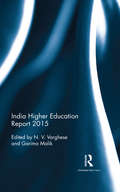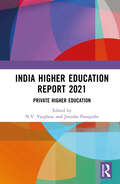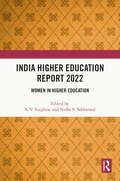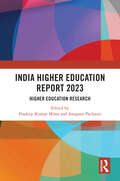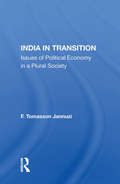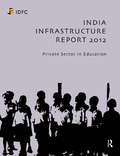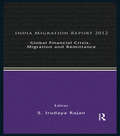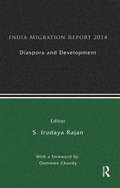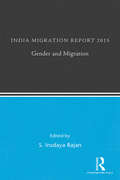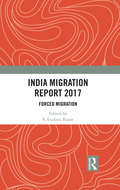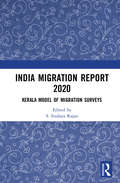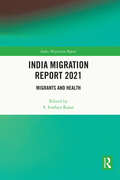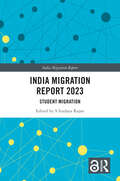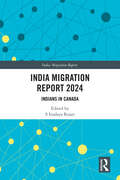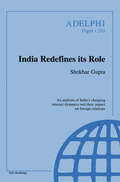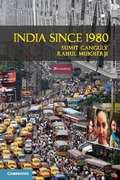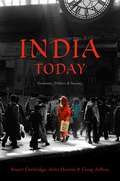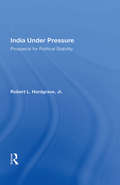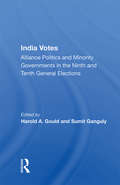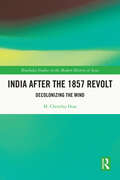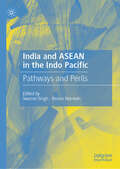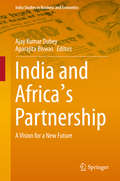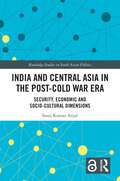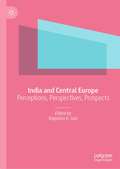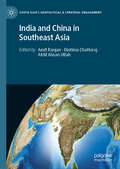- Table View
- List View
India Higher Education Report 2015
by N. V. Varghese Garima MalikThe unprecedented expansion of higher education in India and the proliferation of providers in turn have posed enormous challenges to equity, quality and financing of the sector. The India Higher Education Report 2015 traces the evolution of higher education and discusses the key role of committees and commissions whose reports and recommendations form the backdrop of contemporary developments. Authoritative and comprehensive, the volume examines a range of themes including equity, financing, employment, quality, and governance. It also engages with new and recent data as well as current issues and debates. The volume will be an important resource for academics, policy makers, civil society organisations, media and those concerned with higher education. It will also be useful to scholars and researchers of public policy, sociology and economics.
India Higher Education Report 2021: Private Higher Education
by N. V. Varghese Jinusha PanigrahiThis volume provides an in-depth analysis of the critical dimensions of higher education in India. It focuses on the growth and expansion of private higher education and public policy. The volume discusses issues related to the growth of for-profit and not-for-profit private higher education institutions and their implications at the policy level. It outlines the role of such institutions towards the internationalization and global ranking of the Indian higher education system. The book discusses the trends in internationalisation adopted by private higher education institutions and explains the resulting impact on aspects such as the diversity of programs, skill formation, employability, pedagogic practices, standards, curriculum development, and research and development, as well as the wider externalities in terms of promoting India’s soft power and international relations with other countries. While outlining the challenges of Open Distance Learning (ODL) and online education in India, the book also discusses the use of ICT, OER, and MOOCS among others to address the challenges of the ODL system. This volume will be of interest to teachers, students, and researchers of education, public policy, political science, international relations, law, sociology, economics, and political economy. It will also be useful for academicians, policymakers, and anyone interested in the internationalization of Indian Higher Education.
India Higher Education Report 2022: Women in Higher Education
by N. V. Varghese Nidhi S. SabharwalThis book studies the various dimensions of gender inequality that persist in higher education and employment in India. It presents an in-depth analysis of the complex challenges women face in higher education participation and translating higher education opportunities into labour market success and to leadership positions, including in academia. It argues that despite a substantial progress towards gender equality in enrolment, these inequalities pose as barriers in realising the transformative role that higher education can have for women’s wellbeing and for the nation’s development. The volume looks at the issues that keep women from accessing the areas of their choice, and the challenges they face in leadership positions in higher education. An important critique of higher education policy and planning, the volume will be of interest to teachers, students, and researchers of education, public policy, political science and international relations, economics, feminism, women’s studies, gender studies, law, and sociology. It will also be useful for academicians, policymakers, and anyone interested in the study of gender in Indian Higher Education.
India Higher Education Report 2023: Higher Education Research
by Pradeep Kumar Misra and Anupam PachauriThis book traces the contours of higher education research in India. It analyses the Indian higher education system that has seen unprecedented expansion in the last couple of decades with increasing institutional and programme diversification, diverse participants accessing higher education, and curricula becoming more market oriented in a globalised context.The book provides an empirical analysis of issues related to higher education research in the country including international collaboration; analysis of institutions and research programs; and state- and national-level policies determining higher education and research trajectories. It explores the extent to which sources and supplies of funding impact research agenda, research questions, and outcomes. The book conceptually engages with the role of higher education research in providing a direction for policymakers and paving the way towards quality higher education.An important critique of higher education policy and planning, this book will be valuable for researchers and scholars in the field of education, public policy, political science, international relations, law, sociology, economics, and political economy. It will also be of interest to policy makers working in higher education and research.
India In Transition: Issues Of Political Economy In A Plural Society
by F. Tomasson JannuziIn this book, the author makes some generalizations about contemporary India and the years immediately ahead daring to set forth some of his personal concerns for critical review by those in the United States and in India who share in varying degrees his concern for India's future.
India Infrastructure Report 2012: Private Sector in Education
by Idfc FoundationToday, India’s education sector remains a victim of poor policies, restrictive regulations and orthodoxy. Despite being enrolled in schools, children are not learning adequately. Increasingly, parents are seeking alternatives through private inputs in school and tuition. Students are dropping out from secondary school in spite of high financial returns of secondary education, and those who do complete it have inferior conceptual knowledge. Higher education is over-regulated and under-governed, keeping away serious private providers and reputed global institutes. Graduates from high schools, colleges and universities are not readily employable, and few are willing to pay for skill development. Ironically, the Right to Education Act, if strictly enforced, will result in closure of thousands of non-state schools, and millions of poor children will be left without access to education. Eleventh in the series, India Infrastructure Report 2012 discusses challenges in the education sector — elementary, secondary, higher, and vocational — and explores strategies for constructive change and opportunities for the private sector. It suggests that immediate steps are required to reform the sector to reap the benefits from India’s ‘demographic dividend’ due to a rise in the working age population. Result of a collective effort led by the IDFC Foundation, this Report brings together a range of perspectives from academics, researchers and practitioners committed to enhancing educational practices. It will be an invaluable resource for policymakers, researchers and corporates.
India Migration Report 2012: Global Financial Crisis, Migration and Remittances (India Migration Report)
by S. Irudaya RajanThis volume is a collection of articles dealing with various dimensions of the Global Financial Crisis and its economic and social impact in terms of governance, emigration, remittances, return migration and re-integration. The crisis, which had its origin in the United States in 2008, spread its economic effects on developed as well as developing countries. Some of these countries were able to recover in the short run while some are in the process of recovery, with continuous efforts by both national governments and international agencies. In this backdrop, is there any impact on the outflow of emigrants from the countries of origin and inflow of remittances to the countries of destination? The third volume in the annual series ‘India Migration Report’ answers the question through rigorous quantitative and qualitative analyses and fieldwork both in the Gulf region and South Asia, and concludes that both emigration and remittances are more resilient than expected. This report: contains findings based on an extensive survey conducted in Kerala; has additional evaluations based on other surveys and case studies conducted in different parts of India, Pakistan, Bangladesh, Nepal and Sri Lanka to reflect on the consequences of the global crisis on the countries of origin, as well as a quick assessment and site visits to the United Arab Emirates, Kuwait, Qatar and Malaysia; includes essays that examine the linkages between emigration and remittances based on international data from the World Bank, the International Labour Organization, the International Organization of Migration, the United Nations and other organizations that closely deal with international migration. It will be of interest to students and scholars of migration studies, sociology, law, economics, gender studies, diaspora studies, international relations and demography, apart from non-governmental organizations, policy-makers and government institutions working in the field of migration.
India Migration Report 2014: Diaspora and Development (India Migration Report)
by S. Irudaya RajanIndia Migration Report 2014 is one of the first systematic studies on contribution of diasporas in development, in countries of origin as well as destination. This volume: examines how diasporic human and financial resources can be utilized for economic growth and sustainable development, especially in education and health; offers critical insights on migrant experiences, transnationalism and philanthropic networks, and indigenization and diaspora policies, as well as return of diasporas; and includes case studies on Indian migrants in the Gulf region — in particular, Bahrain, Oman and Saudi Arabia — and the United Kingdom, among others. With essays by major contributors, the volume will interest scholars and researchers on economics, development studies, migration and diaspora studies, and sociology. It will also be useful to policy-makers and government institutions working in the area.
India Migration Report 2015: Gender and Migration (India Migration Report)
by S. Irudaya RajanIndia Migration Report 2015 explores migration and its crucial linkages with gender. This volume: • studies important issues such as irregular migration, marriage migration and domestic labour migration, as well as the interconnections of migration, gender and caste; • highlights the relationship between economics and changing gender dynamics brought about by migration; and • documents first-hand experiences of migrants from across India. Part of the prestigious annual series, this work will be useful to scholars and researchers of development studies, economics, migration and diaspora studies, and sociology. It will also interest policy-makers and government institutions working in the area.
India Migration Report 2017: Forced Migration (India Migration Report)
by S. Irudaya RajanThe India Migration Report 2017 examines forced migration caused by political conflicts, climate change, disasters (natural and man-made) and development projects. India accounts for large numbers of internally displaced people in the world. Apart from conflicts and disasters, over the years development projects (including urban redevelopment and beautification), often justified as serving the interests of the people and for public good, have caused massive displacements in different parts of the country, disrupting the lives and livelihoods of millions of people. The interdisciplinary essays presented here combine a rich mix of research methods and include in-depth case studies on aspects of development-induced displacement affecting diverse groups such as peasants, religious and ethnic minorities, the poor in urban and rural areas, and women, leading to their exclusion and marginalization. The struggles and protests movements of the displaced groups across regions and their outcomes are also assessed. This volume will be of great interest to scholars and researchers of development studies, economics, sociology and social anthropology and migration studies.
India Migration Report 2020: Kerala Model of Migration Surveys
by S. Irudaya RajanIndia Migration Report 2020 examines how migration surveys operate to collect, analyse and bring to life socio-economic issues in social science research. With a focus on the strategies and the importance of information collected by Kerala Migration Surveys since 1998, the volume: Explores the effect of male migration on women left behind; attitudes of male migrants within households; the role of transnational migration and it effect on attitudes towards women; Investigates consumption of remittances and their utilization; asset accumulation and changing economic statuses of households; financial inclusion of migrants and migration strategies during times of crises like the Kerala floods of 2018; Highlights the twenty-year experience of the Kerala Migration Surveys, how its model has been adapted in various states and led to the proposed large-scale India Migration Survey; and Explores issues of migration politics and governance, as well as return migration strategies of other countries to provide a roadmap for India. The volume will be of interest to scholars and researchers of development studies, economics, demography, sociology and social anthropology, and migration and diaspora studies.
India Migration Report 2021: Migrants and Health (India Migration Report)
by S. Irudaya RajanIndia Migration Report 2021 presents a detailed study on the health of migrants. It highlights major healthcare challenges faced by migrant labourers, especially in the context of the COVID-19 pandemic, which has forced authorities, policymakers and many other stakeholders to turn their attention to healthcare delivery unlike ever before. Bringing to the fore the health status of the migrant population both before the pandemic and during the pandemic, the essays in this volume discuss • the ease of access of migrant labourers to primary healthcare services; • the safety challenges faced by migrant workers at their workplaces, their exposure to various physical and psychological health vulnerabilities, and prevalence of potentially malignant health disorders and mental health issues among migrant labourers; • gendered access to healthcare, gender-based violence at workplaces and the gender-related perceptions on topics such as employment, decision-making and general attitude; • the role of decentralization and local self-government institutions in enabling health systems to address health problems of migrants, government policies and programs aimed at providing welfare for return emigrants from the Gulf; • the vulnerabilities migrant workers have encountered across the Indian states during the pandemic, with regards to food insecurity and psychological distress, and the type of support they received from various stakeholders. The volume will be of interest to scholars and researchers of development studies, economics, demography, sociology and social anthropology, and migration and diaspora studies.
India Migration Report 2023: Student Migration (India Migration Report)
by S Irudaya RajanThe India Migration Report 2023: Student Migration is one of the first books that attempts to comprehensively explore the various nuances of Indian international student migration factoring in multiple factors that influence the migration journey of Indian students. It also looks into other migration stories including internal and international returnees, various impacts of remittances, and migration in the context of the pandemic.This volume: Inspect the factors driving the student migration from India, accounting for both the historical and current happenings influencing these factors. Following the pandemic, the book highlights the challenges faced by Indian international students in accessing health care and other related services which goes on to push them into vulnerable situations Outlines the reasoning behind Indian students' decision to emigrate and how families play an important role in influencing key migration decisions made by students and the different patterns of student migration observed in India Examines the employment challenges experienced, particularly following the COVID-19 pandemic, by the highly skilled Indian migrants and Indian international students Describes the role that recruitment and consultancy agencies play in international student mobility (ISM) and examines the intricate relationship between migrant agencies and migration facilitation Investigates the psychological, economic and social challenges faced by Indian international students during their migration journey both during and after the completion of their course abroad Provides a critical overview of the conditions of both internal and international returnees to different parts of India Studies the impact of remittances on migrant households including their consumption patterns and human capital investment Analyses interstate migration networks through the prism of gender and critically assesses how gender migration patterns have altered throughout time Scholars, students, researchers, academicians, policymakers or anyone with an interest in migration, migration politics, economics, social psychology, migration policies, development studies, sociology, social anthropology and gender studies will find this book on Indian student migration extremely informative. The book is a comprehensive collection of various studies that look into the multiple aspects of student migration but also extend to other pertinent issues of Indian migration that are extremely relevant at this given point in time.
India Migration Report 2024: Indians in Canada (India Migration Report)
by S Irudaya RajanIndia Migration Report 2024: Indians in Canada is one of the first volumes to comprehensively examine and analyse the different facets of Indian migration to Canada.This volume:• Examines the comprehensive history of Indian migration to Canada, including the story of social, cultural, economic, and political integration, analysis of socio-economic characteristics, and evolving political scenarios surrounding student migration and diasporas.• Presents an overview of migration and post-migration experiences of Indian immigrant and Indo-Canadian women and the rising trend of high-skilled Indian female migration to Canada.• Discusses the influence of Canadian immigration policy and its effects on the changing immigration patterns of Indians to Canada.• Examines the challenges faced by Indian immigrants and Indo-Canadians due to deeply entrenched Eurocentric and Ethnocentric biases and the impact of COVID-19 on the community.• Explores the effect of adult children’s migration on the health and suffering from disability of elderly left behind in the migration process.The book also discusses leveraging migration for international development. The book will be of interest to scholars, students, researchers, or anyone interested in migration and diasporic studies, development studies, the politics of migration, immigration policy, social anthropology, economics, and sociology.
India Redefines its Role (Adelphi series #293)
by Shekhar GuptaFirst Published in 2005. Routledge is an imprint of Taylor & Francis, an informa company.
India Since 1980
by Rahul Mukherji Šumit GangulyThis book considers the remarkable transformations that have taken place in India since 1980, a period that began with the assassination of the formidable Prime Minister Indira Gandhi. Her death, and that of her son Rajiv seven years later, marked the end of the Nehru-Gandhi era. Although the country remains one of the few democracies in the developing world, many of the policies instigated by these earlier regimes have been swept away to make room for dramatic alterations in the political, economic and social landscape. Sumit Ganguly and Rahul Mukherji, two leading political scientists of South Asia, chart these developments with particular reference to social and political mobilization, the rise of the BJP and its challenge to Nehruvian secularism and the changes to foreign policy that, in combination with its meteoric economic development, have ensured India a significant place on the world stage.
India Today: Economy, Politics and Society
by Craig Jeffrey Stuart Corbridge John Harriss<p>Twenty years ago India was still generally thought of as an archetypal developing country, home to the largest number of poor people of any country in the world, and beset by problems of low economic growth, casteism and violent religious conflict. Now India is being feted as an economic power-house which might well become the second largest economy in the world before the middle of this century. Its democratic traditions, moreover, remain broadly intact. <p>How and why has this historic transformation come about? And what are its implications for the people of India, for Indian society and politics? These are the big questions addressed in this book by three scholars who have lived and researched in different parts of India during the period of this great transformation.</p>
India Under Pressure: Prospects For Political Stability
by Robert L. HardgraveIndia, as the dominant power in South Asia, is the region’s keystone for stability. Contending that the Indian government is under ever-increasing pressure as a result of internal social and political conflict, Dr. Hardgrave provides a broad survey of the sources of conflict: regionalism, particularly demands for separation and autonomy in Assam and the Punjab; enmity between religious groups, manifested in increased Hindu-Muslim tensions; caste violence; peasant unrest in the countryside; and protests among students and labor groups in the cities. The author analyzes the capacity of India’s political parties, the bureaucracy, and the military to cope with change and to manage the country’s social diversity and the potential for conflict. In particular, he examines the ruling Congress party, the leadership style of Prime Minister Indira Gandhi, the problem of succession, prospects for unity among opposition parties, and the potential impact of a coalition government on political stability. In considering the role that foreign relations play in India’s political stability, Dr. Hardgrave discusses India’s relations with South Asia, the Middle East, the Soviet Union, China, and the United States.
India Votes: Alliance Politics And Minority Governments In The Ninth And Tenth General Elections
by Harold A GouldWithin a scant eighteen-month span, India held two national elections. The first, in November 1989, witnessed the political demise of Rajiv Gandhi and the precipitous decline of his Congress Party. The second, in May 1991, witnessed his assassination at the hands of Tamil Tiger extremists just as the Congress Party seemed poised on the threshold of
India after the 1857 Revolt: Decolonising the Mind (Routledge Studies in the Modern History of Asia)
by M. Christhu DossWeaving together the varied and complex strands of anti-colonial nationalism into one compact narrative, Christhu Doss takes an incisive look at the deeper and wider historical process of decolonization in India. In India after the 1857 Revolt, Doss brings together some of the most cutting-edge thoughts by challenging the cultural project of colonialism and critically examining the multi-dimensional aspects of decolonization during and after the 1857 revolt. He demonstrates that the deep-rooted popular discontent among the Indian masses followed by the revolt generated a distinctive form of decolonization movement—redemptive nationalism that challenged both the supremacy of the British Raj and the cultural imperatives of the controversial proselytizing missionary agencies. Doss argues that the quests for decolonization (of mind) that got triggered by the revolt were further intensified by the Indocentric national education; the historic Chicago discourse of Swami Vivekananda; the nonviolent anti-colonial struggles of Mahatma Gandhi; the seditious political activism displayed by the Western Gandhian missionary satyagrahis; and the de-Westernization endeavours of the sandwiched Indian Christian nationalists. A compelling read for historians, political scientists and sociologists, it is refreshingly an indispensable guide to all those who are interested in anticolonial struggles and decolonization movements worldwide.
India and ASEAN in the Indo Pacific: Pathways and Perils
by Reena Marwah Swaran SinghThis book investigates India-ASEAN partnership and their overlapping perspective on the Indo-Pacific region and big powers' contestation and competition in this region providing specific nuances and newer insights. It is policy-oriented and examines the confluence of ASEAN’s Outlook for Indo-Pacific (AOIP) and India’s Indo-Pacific Oceans Initiative (IPOI). It brings out various contemporary geopolitical drivers that highlight the hidden complementarities and gaps in India-ASEAN multi-sectoral connectivity and its future. The book provides a balanced assessment of evolving trends, undergirded by theoretical debates and empirical analyses with diverse sub-regional and country perspectives of the intersection between the potential for regional convergence, domestic capacity issues, and security interests. It is thus of immense use for thinktanks and media commentators, policy makers, and researchers of Indo-Pacific & Asian affairs, international relations, and China-US relations, interested in evolving contours of Indo-Pacific geopolitics.
India and Africa's Partnership
by Ajay Kumar Dubey Aparajita BiswasThis book demonstrates the changing dynamics of India's engagement with Africa, focusing on trade, investment, official development assistance, capacity building activities and the diaspora. It also examines its impact at the economic, political and societal levels with respect to governance, democratic structures, education and health. India has competitive edge of historical goodwill and it is one of the most important countries engaging Africa in the 21st Century. For Africa, India has emerged from an aid recipient country to a major aid provider but on a basis of partnership model. The book provides a contemporary analysis and assessment of Indo-Africa relations, bringing together contributions from the Global South and from the North that explore whether the relationship is truly 'mutually beneficial'.
India and Central Asia in the Post-Cold War Era: Security, Economic and Socio-Cultural Dimensions (Routledge Studies in South Asian Politics)
by Saroj Kumar AryalThis book analyses the evolution of India’s foreign policy towards Central Asia after the end of the Cold War.Focusing on the development of India’s foreign policy towards Central Asia between 1991 and 2020, this book investigates the explanatory and intervening variables of the policy towards the region to identify its goals, assumptions, motivations and instruments. The preliminary assumption is that India’s foreign policy towards Central Asia has evolved after the Cold War from a passive approach to an active participant in Central Asian security, economic and socio-cultural spheres. This is also seen due to the emergence of the five Central Asian countries as independent states, which have a tremendous strategic significance due to their geographical location, huge hydrocarbon reserve and potential economic opportunities. India expanded its policy to the ‘Extended Neighbourhood,’ adding East, Central and West Asia to the existing South Asian neighbourhood. Since then, India has been engaging with the region considering the growing geostrategic and geo-economic significance of the region and using the available foreign policy instruments. This book presents a comprehensive assessment of India’s foreign policy behaviour evolution with proper analysis of the explanatory (external) and intervening (internal) variables that influence India’s behaviours towards the region. It shows that India also aims to be a very influential power in Central Asia. This book will be an excellent resource for students and researchers of area and global studies, international relations, Asian Politics and South and Central Asia.
India and Central Europe: Perceptions, Perspectives, Prospects
by Rajendra K. JainThis book explores the transformation of India’s relations with Central and Eastern Europe from being a subset of Indo-Soviet relations during the Cold War to the rediscovery and rebuilding of relations with the region almost from scratch in the post-Cold War era. It examines how the combination of Brexit, the rise of China and India’s expanding geo-economic interests in Europe has led the Narendra Modi government to contemplate relations with Central Europe through a more strategic lens and treat the region as an autonomous element within India’s foreign policy rather than a footnote of its relations with other great powers. Fulfilling a long-felt gap in existing literature, this volume examines India’s political, economic, investment, defence and cultural relations with the Visegrad Four (the Czech Republic, Hungary, Poland and Slovakia). It analyzes Indian perceptions of Central Europe and explores prospects of New Delhi’s political and economic engagement with the region. The painstakingly compiled appendices on the exchange of bilateral visits and agreements between India and the Visegrad Four would be of immense use as a handy reference to scholars, policy-makers, and other interested persons and institutions.
India and China in Southeast Asia (South Asia’s Geopolitical & Strategic Engagement)
by Akm Ahsan Ullah Amit Ranjan Diotima ChattorajThis book focuses on the increasing contest and limited cooperation between India and China in Southeast Asia, which is beyond their shared border. This sort of engagement shows how their bilateral tensions are also playing out in the extraterritorial region where the two countries are involved because of history, economics, and security reasons. Chapters in this book look at the various facets of their engagements in the Southeast Asia. It contains both thematic and bilateral issues. Some of the chapters such as on infrastructure, defence etc takes stock of India-China engagements in Southeast Asia, while others mainly deal with how the two Asian powers interact with the individual countries of the region. The readers will benefit from this comprehensive volume in following ways: (a) They will come to know how and why Southeast Asia is an important region for India and China; (b) They will get an idea of how India and China are trying to engage with the Southeast Asia as a regionand at the bilateral level; (c) The readers will understand the role of the Diasporas in linking their respective country of origin with the States they live in ; and ( d) the readers will get aware of how the Asian powers are contesting against each other in the Southeast Asia region for their benefits
